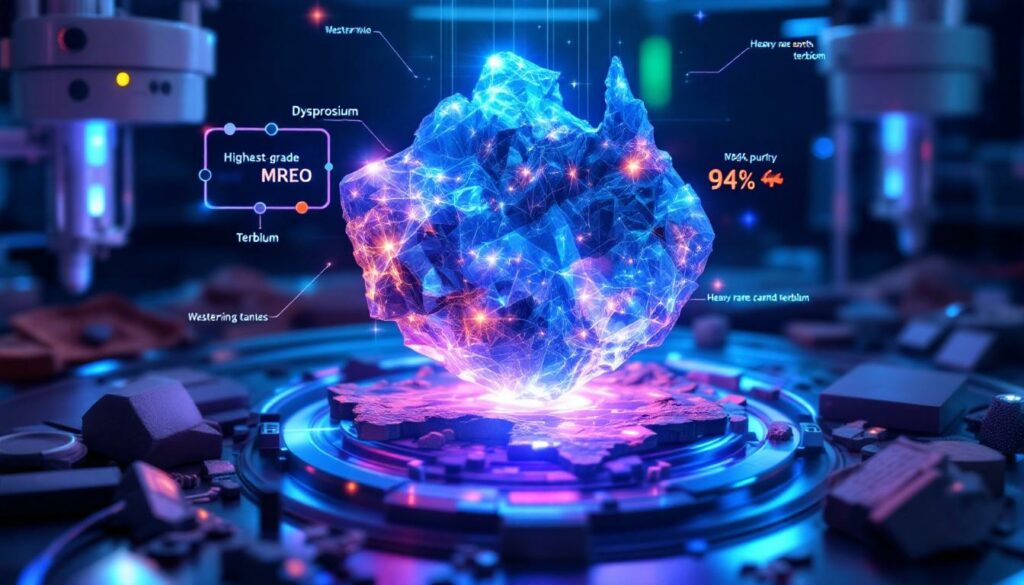Understanding Victory Metals' Breakthrough in Australian Rare Earth Production
Victory Metals has achieved a groundbreaking milestone in Australia's rare earth industry by producing a mixed rare earth oxide (MREO) product containing 94% total rare earth oxides (TREO) from its North Stanmore project in Western Australia. This achievement represents the highest-grade heavy rare earth-enriched MREO ever produced in Australia from a clay-hosted rare earths system, establishing a new benchmark for the entire sector.
According to Brendan Clark, CEO of Victory Metals, "This is one of the most significant technical and commercial breakthroughs in Victory's journey so far… To produce a 94 percent TREO mixed rare earth oxide in Australia from a clay-hosted system is, to our knowledge, a first in Australia."
The significance of this achievement extends beyond just breaking records—it demonstrates the viability of developing alternative rare earth sources outside of China's dominant supply chain, addressing growing global concerns about critical minerals and energy security.
The Technical Achievement Explained
The 94% TREO content achieved by Victory Metals represents an exceptional purity level that validates the company's proprietary processing technology. This milestone is particularly remarkable considering it was achieved using a clay-hosted deposit, which traditionally presents more processing challenges than hard-rock deposits like those operated by Lynas Corporation at Mt. Weld.
What makes this achievement truly significant is that Victory accomplished this without employing the capital-intensive concentration or cracking processes typically required in rare earth production. The company's innovative approach could potentially revolutionize how clay-hosted rare earth deposits are developed globally.
"The samples used for this test work were not 'cherry-picked'," Clark emphasized, "which highlights the true commercial value of North Stanmore's rare earth mineralization."
The technical accomplishment involved:
- Record-setting purity level: 94% TREO content in the mixed rare earth oxide product
- First of its kind: First high-grade heavy rare earth-enriched MREO from an Australian clay-hosted system
- Validation of proprietary technology: Confirms the viability of Victory's processing flowsheet developed in partnership with ALS metallurgy laboratory
North Stanmore Project Specifications
The North Stanmore project in Western Australia has demonstrated remarkable consistency across its deposit. The test work involved:
- 453 individual samples collected across the deposit
- Average grade of 525 parts per million (ppm) TREO
- Comprehensive composite sampling demonstrating deposit uniformity
- Strategic location within Australia's expanding rare earth production corridor
This uniformity is particularly significant for commercial viability, as it suggests the potential for consistent production without the need for complex blending operations that plague some rare earth developments.
How Does Victory Metals' Process Differ From Traditional Rare Earth Production?
Traditional rare earth processing typically involves multiple complex, energy-intensive steps including mining, crushing, grinding, flotation, chemical leaching, solvent extraction, and precipitation. These conventional approaches often require capital expenditures exceeding $1 billion for commercial-scale operations, creating significant barriers to entry.
Innovative Processing Advantages
Victory Metals' approach represents a paradigm shift in rare earth processing:
- Simplified extraction: Achieved without capital-intensive concentration or cracking processes that can account for 40-60% of project capital expenditure
- High-quality output: Product essentially free from deleterious elements such as iron and phosphorus, which typically complicate downstream processing
- Processing milestone: Most advanced downstream processing point prior to rare earth separation and metallization
- Technical partnership: Developed with ALS metallurgy laboratory and Victory's in-house team, combining leading expertise in rare earth processing
"Our proprietary flowsheet allows us to bypass several costly and complex steps in the rare earth production chain," noted Clark in the company's ASX announcement. "This not only reduces potential capital requirements but also minimizes environmental impacts typically associated with traditional processing methods."
Unlike Lynas Corporation's approach at Mt. Weld, which requires multiple stages including drying, roasting, and chemical cracking to produce primarily cerium and lanthanum, Victory's process demonstrates a more direct pathway to a high-purity mixed rare earth product with significant heavy rare earth content.
Commercial Implications
The simplified processing approach could transform the economics of clay-hosted rare earth deposits worldwide:
- Cost efficiency: Potentially lower capital expenditure by 30-40% compared to traditional processing methods
- Marketability enhancement: Clean product profile with minimal contaminants increases attractiveness to buyers in high-tech manufacturing
- Strategic positioning: Strengthens position as a non-Chinese rare earth source at a time when supply chain security is paramount
- Environmental benefits: Reduced chemical usage and waste generation compared to conventional processing approaches
Industry analysts note that this advancement could make previously uneconomic clay-hosted deposits viable, potentially expanding the global rare earth resource base at a critical time when demand is accelerating due to green technology applications.
Why Are Heavy Rare Earths Particularly Valuable?
Heavy rare earths—including dysprosium, terbium, europium, and yttrium—represent the most strategically valuable segment of the rare earth market. Despite constituting only about 20% of total rare earth elements by volume, they command approximately 50% of the market value, according to USGS data.
Strategic Importance of Heavy Rare Earths
The particular value of heavy rare earths stems from several factors:
- Higher market value: Heavy rare earths like dysprosium can command prices 20-30 times higher than light rare earths like cerium
- Supply constraints: More limited global availability with production concentrated in southern China and a handful of other locations
- Critical applications: Essential components in high-tech products including wind turbines, electric vehicles, military systems, and medical technologies
- Market demand: Growing need for secure, non-Chinese sources has intensified as geopolitical tensions rise
During the 2010-2014 period when China implemented export restrictions, prices for some heavy rare earths increased by over 500%, highlighting the market vulnerability. More recently, europium prices have shown similar volatility, demonstrating the ongoing supply challenges.
Global Supply Chain Considerations
The heavy rare earth market presents unique supply chain dynamics:
- Strategic diversification: Western nations are actively supporting projects that reduce reliance on dominant Chinese suppliers
- Geopolitical significance: Heavy rare earths feature prominently in critical minerals reserve strategies of Australia, the US, EU, and Japan
- Industry interest: Already attracting elevated offtake interest from potential partners seeking supply security
- Technological applications: Essential for permanent magnets that enable miniaturization in consumer electronics and efficiency in renewable energy systems
"In a tightening global market for rare earth elements, particularly the valuable heavy rare earths present in our deposit, we're experiencing significantly elevated offtake interest," Clark stated in the ASX announcement.
Industry forecasts project that demand for heavy rare earths could grow at 8-12% annually through 2030, driven primarily by expansion in renewable energy and electrification of transportation systems.
What Does This Mean for Australia's Rare Earth Industry?
Australia has positioned itself as a key alternative supplier in the global rare earth market, with exports valued at approximately $1.4 billion in 2021-22 according to Australian Bureau of Statistics data. However, this production has been dominated by Lynas Corporation's operations, which focus primarily on light rare earths.
National Strategic Implications
Victory Metals' achievement represents a significant advancement for Australia's rare earth sector:
- Industry advancement: Sets new technical standards for Australian rare earth processing capabilities
- Sector development: Demonstrates viability of clay-hosted rare earth deposits in Australia, expanding the potential resource base
- Export potential: Enhances Australia's position in global rare earth supply chains, particularly for heavy rare earths
- Economic benefits: Potential for downstream value addition within Australia rather than exporting concentrates for overseas processing
The Australian government has identified rare earths as a priority within its defence critical materials strategy, offering potential support mechanisms for projects that enhance domestic processing capabilities and supply chain security.
Future Development Pathway
Victory Metals' progress opens several strategic pathways:
- Offtake discussions: Company actively progressing strategic partnership conversations with potential end-users
- Shareholder focus: Emphasis on partnerships that support long-term shareholder value rather than opportunistic sales
- Technical validation: Proven processing capability strengthens negotiating position with potential partners
- Scale-up potential: Demonstrated uniformity of deposit supports commercial development planning
"We're strategically progressing offtake conversations with partners who align with our vision for creating long-term shareholder value," explained Clark. "The technical achievement we've announced significantly strengthens our position in these discussions."
The development represents a potential diversification of Australia's rare earth production capabilities, which have historically focused on light rare earth elements from hard-rock deposits like Mt. Weld.
FAQ: Victory Metals' Rare Earth Production
What exactly has Victory Metals achieved?
Victory Metals has produced a 94% TREO mixed rare earth oxide product from its North Stanmore project, representing the highest-grade heavy rare earth-enriched MREO ever produced in Australia from a clay-hosted system. This achievement validates the company's proprietary processing technology and demonstrates the viability of a simplified production pathway for clay-hosted rare earth resources.
Why is the heavy rare earth content significant?
Heavy rare earths are typically more valuable and in shorter supply globally, making deposits with higher heavy rare earth content particularly strategic and economically attractive. For context, while light rare earths like cerium might trade at $5-10/kg, heavy rare earths like dysprosium can command $200-300/kg depending on market conditions. This price differential makes heavy rare earth-enriched deposits substantially more valuable on a per-tonne basis.
How does this compare to other rare earth projects?
This achievement sets a new benchmark for the Australian rare earth sector, particularly for clay-hosted deposits, which have traditionally been more challenging to process economically. Most Australian production comes from hard-rock deposits like Lynas Corporation's Mt. Weld, which focuses primarily on light rare earths. Victory's achievement demonstrates a pathway for clay-hosted deposits to produce high-purity products with significant heavy rare earth content, potentially expanding Australia's rare earth resource base.
What are the next steps for Victory Metals?
The company is progressing offtake discussions with strategic partners while continuing to develop its proprietary processing technology toward commercial implementation. Key milestones likely include pilot plant testing, preliminary economic assessment, and partnership development. The uniformity of the deposit provides a solid foundation for scale-up planning as the company transitions from technical validation to commercial development.
Future Outlook for Victory Metals and Australian Rare Earths
Near-Term Development Priorities
Victory Metals' path forward involves several strategic priorities:
- Partnership development: Securing strategic offtake agreements with aligned partners seeking supply chain security
- Process optimization: Further refining the proprietary processing flowsheet to maximize recovery rates and product quality
- Project advancement: Moving toward commercial-scale implementation through pilot testing and engineering studies
- Market positioning: Leveraging technical achievement to strengthen market position as a non-Chinese source of heavy rare earths
The company's approach aligns with broader trends in the rare earth sector, which increasingly emphasize simplified processing, reduced environmental impacts, and strategic partnerships with end-users.
Long-Term Industry Impact
The broader implications for Australia's rare earth industry include:
- Processing innovation: Potential to transform economics of clay-hosted rare earth deposits globally
- Supply diversification: Contributing to global rare earth supply chain security at a time of increasing geopolitical tension
- Technical leadership: Establishing Australia as a leader in rare earth processing technology beyond conventional approaches
- Resource utilization: Enabling development of previously challenging rare earth resources, expanding the viable resource base
As global demand for rare earth elements continues to grow, driven by renewable energy technologies, electric vehicles, and defense applications, innovations like those demonstrated by Victory Metals will play an increasingly important role in ensuring supply chain resilience and resource sustainability. Furthermore, with ongoing mining industry innovation and AI mining breakthroughs, companies like Victory Metals are well-positioned to lead the next generation of resource development in Australia.
Disclaimer: This article contains forward-looking statements about Victory Metals' rare earth production and technology development. Actual results may differ materially from these projections due to various factors including market conditions, technical challenges, and regulatory developments. Readers should conduct their own research before making investment decisions.
Ready to Invest in the Next Major Mineral Discovery?
Discovery Alert's proprietary Discovery IQ model delivers instant notifications when significant ASX announcements occur, turning complex mineral data into actionable insights for investors interested in rare earth and critical mineral opportunities. Explore why major mineral discoveries can lead to substantial returns by visiting Discovery Alert's dedicated discoveries page.




